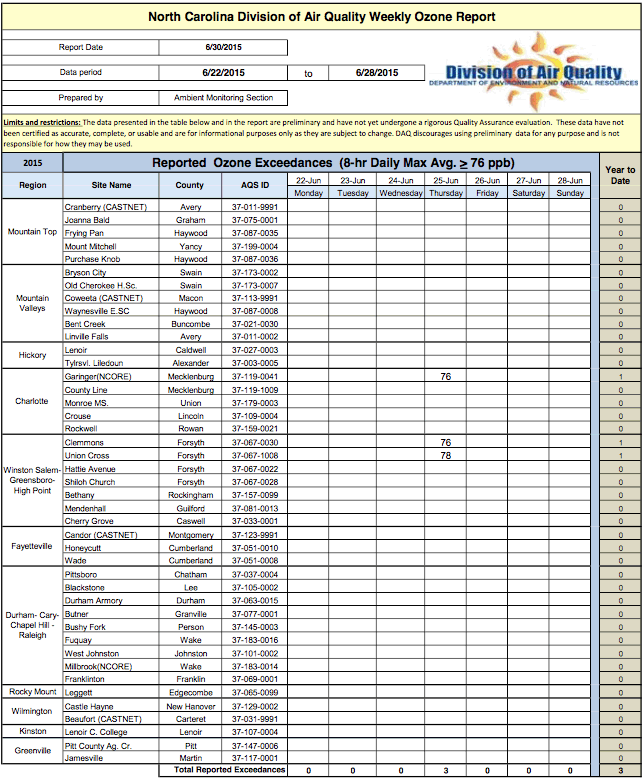The last time any ozone (smog) monitor in North Carolina registered a reading that exceeded EPA’s maximum standard of 75 parts per billion in ambient air was May 15, 2013 on one monitor in the Triad. Last year appears to have been the best on record, with no monitors registering a high ozone reading for the entire season. Due to the extremely high heat and humidity that we experienced over the last couple of weeks, the streak has come to an end. During the week of June 22nd to June 28th, three monitors — two of the seven monitors in the Triad region and one of the five monitors in the Charlotte region — edged above the EPA standard. Despite the recent anything-but-balmy weather that was very conducive to the formation of ozone in the atmosphere, the two monitors in the triad had readings of only 76 and 78 ppb while the high ozone reading in Charlotte was 76 ppb. All three of these occurred on one day, June 25th. (The usual weekly ozone reports is in item 3 below including the table listing all of the monitors and their highest ozone readings for the week.)
2. Dr. Roy Spencer explains: "What is the Greenhouse Effect?"
Earth’s greenhouse effect, which is responsible for the fact that the planet is warm enough to support life as we generally know it and is what makes weather possible, is an immensely complicated phenomena with many factors going into it. This is in spite of the fact that global warming alarmists portray the greenhouse effect as pretty simple, being almost exclusively caused by CO2 in the atmosphere. In fact, water vapor is by far the dominant greenhouse gas. I suggest that anyone interested in how this all works should read this short explanation. Warning, it is somewhat technical but, as I said, the phenomenon is complicated, and if anyone can make it intelligible, it is Dr. Spencer. The greenhouse effect is the starting point for the entire debate surrounding global warming.
3. Ozone Report
The 2015 ozone season began on April 1st and, as I have been doing since this newsletter was started, each week during the ozone season this newsletter will report how many, if any, high ozone days have been experienced throughout the state during the previous week, where they were experienced, and how many have been recorded during the entire season to date. (Note: ground level ozone, which is what we are reporting on, is often called "smog.") According to current EPA standards, a region or county experiences a high ozone day if a monitor in that area registers the amount of ozone in the air as 76 parts per billion (ppb) or greater. The official ozone season will end on October 31st. All reported data is preliminary and issued by the North Carolina Division of Air Quality, which is part of the state’s Department of Environment and Natural Resources. Thus far this season there have been three high ozone days recorded on any of the state’s 42 monitors. All three occurred on June 25th of this week.
The table below shows all of the North Carolina’s ozone monitors and the high reading on those monitors for each day of the 7-day period, June 22-28.

Click here for the Economics & Environment Update archive.
You can unsubscribe to this and all future e-mails from the John Locke Foundation by clicking the "Manage Subscriptions" button at the top of this newsletter.


